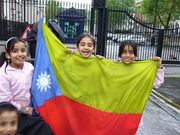| |||||||
| Capital | Zaranj | ||||||
| Largest city | Zaranj | ||||||
| Language official |
Balochi | ||||||
| others | Pashto | ||||||
| Religion | Sunni Islam | ||||||
| Ethnic Group | Baloch, Pashtun | ||||||
| President | Abdul Karim Brahui | ||||||
| Speaker of Parliament | Ghulam Dastagir Azad | ||||||
| Area | approx. 25,000 km² | ||||||
| Population | approx. 125,000 | ||||||
| Established | 1984 | ||||||
| Currency | Baloch Dinar | ||||||
The Islamic Republic of Balochistan (or Balochistan) is a country in former southwest of Afghanistan. The country is located in an arid, mountainous region in southwestern Afghanistan. It extends into southeastern Iran and western Pakistan and is named after the Baloch tribes which moved into the area from the west around 1000 AD.
History[]
Pre-Doomsday[]

Baloch Children celebrating Independence Day
The main Baloch areas located in Balochistan province in Pakistan and Sistan and Baluchistan province of Iran. Many also live in southern Afghanistan. They are most likely an offshoot of the Kurds and reached Afghanistan sometime between 1000 and 1300 BCE. Mainly pastoral and desert dwellers, the Baluch are also Sunni Muslim. The Baluch population in Afghanistan numbered approximately 200,000, largely centered in Nimruz Province.
Doomsday[]
On Doomsday, no part of Balochistan was nuked, but after Kabul and other parts of Afghanistan were destroyed, the country fell into chaos and disorder. During the chaos new sects of Islam came into being, many attempting to explain Doomsday in relation to Allah. In one case, the city of Ghazni, a version arose in which they believe that Doomsday was a punishment from Allah to the world and that a man call Mohammed Sarabi was Mohammed born again in the world.
Post-Doomsday[]
With the destruction of Soviet power in Afghanistan, as well as two of its major cities, the Communist government quickly lost control over the country. Nevertheless, the Mujahideen suffered just as greatly due fallout and the indirect effects of Doomsday. The situation was made worse as the Mujahideen harried the fleeing Soviet troops as they made there way towards Siberia.
With the destruction of Communist Afghanistan government and the evacuation of the Soviet troops, rebels groups began to carve out areas of control as Afghanistan fell into anarchy. In the southwest of the country, the group the "Partisans of National Liberation of Afghanistan" (or Front of Nimruz) moved back into Nimruz Province. A Baluchi nationalist guerrilla group, representing Afghani Baluchis and also Pashtuns in the south and southwest of Afghanistan, the Front Nimruz established control over most of the province. A few isolated Balochs and Pashtuns also fled there as well.
Despite various attempts, Balochistan was unable to expand its control over form Afghan territory except for a small enclave around the city of Zaranj.
Alliance with Iran[]
Balochistan has been in contact with Iran since its formation. By the 1990s, small amounts of trade began between the two countries. Iran, however, did not recognize the country until the Pakistani intervention in Afghani Civil War. Shortly thereafter, Iran officially recognized and allied itself with Balochistan on June 16, 2009, providing them with weapons and other supplies. The Iranian government did not want Pakistan to have too much influence in Afghanistan before Iran could carve out their own sphere.
Since the alliance, Balochistan has expanded its border to gain control over much of the former Nimruz Province, as well as some Baloch areas in Farah Province near the border. Currently, they are working on gaining some measure of control over the deserts in the southern half of former province. Iranian advisors were present during these expansions and often were part of the decision making.
Government[]
Balochistan is governed by a President, and a Parliament elected by the people, headed by the Speaker. All positions are currently filled, though no elections have actually been held as of yet.
Military[]
The nation does have a small armed militia, numbering only a couple thousand men. They do, however, have support from the Iranian Army if they need it.
Ethnography[]
61% people are Balochs, forming the majority in the province, and Pashtuns are 27% of the population. There are also some Tajiks and Uzbeks. Around 85% of the people in Nimruz live in rural areas while 15% live in urban areas.
International Relations[]
Balochistan is today almost puppet of Iran. Unfortunately, they are becoming increasingly dominated by them by the day.
It is suspected that the Iranians will use Balochistan as a base for the MLA as well, though this is still only hearsay.
| ||||||||||||||||||||||




